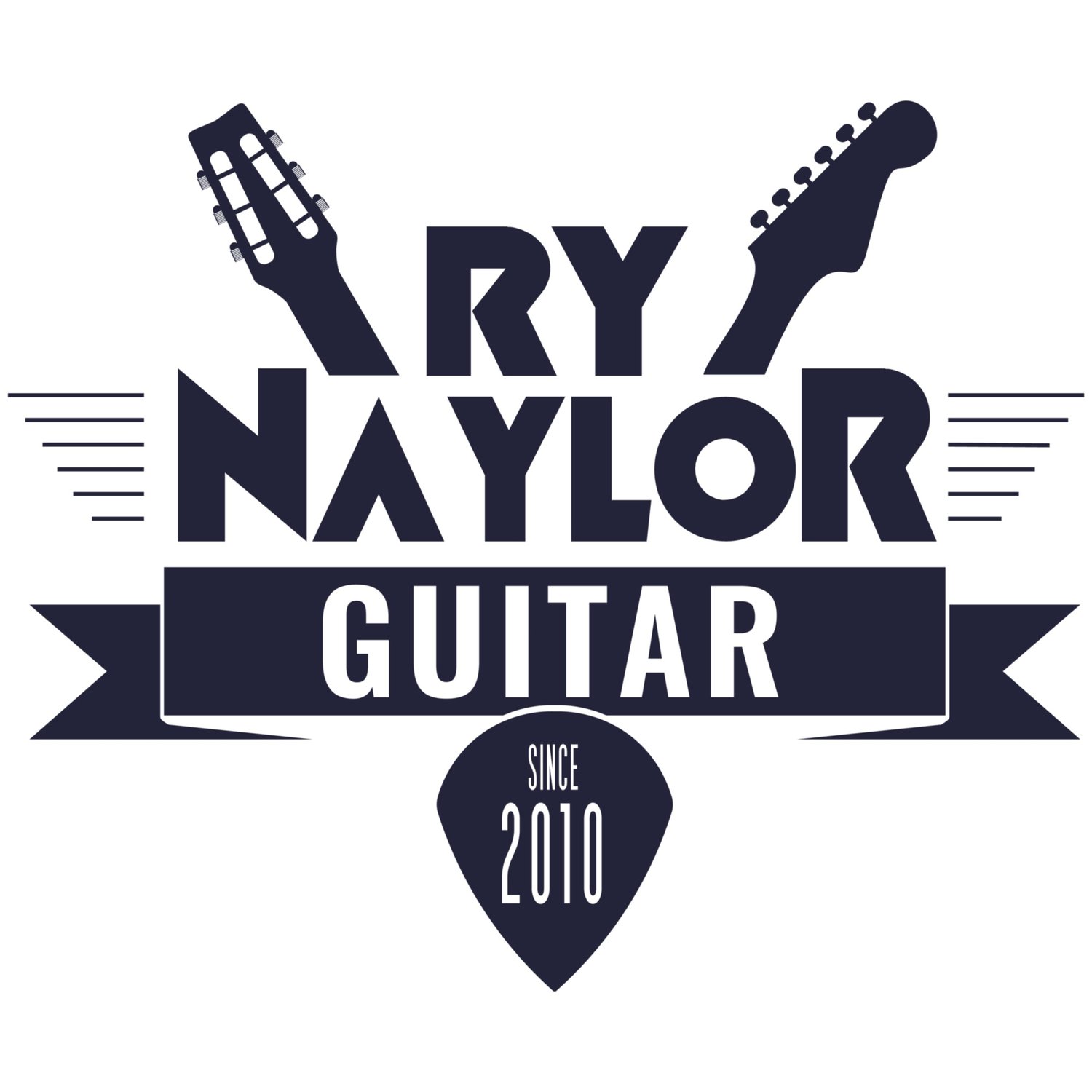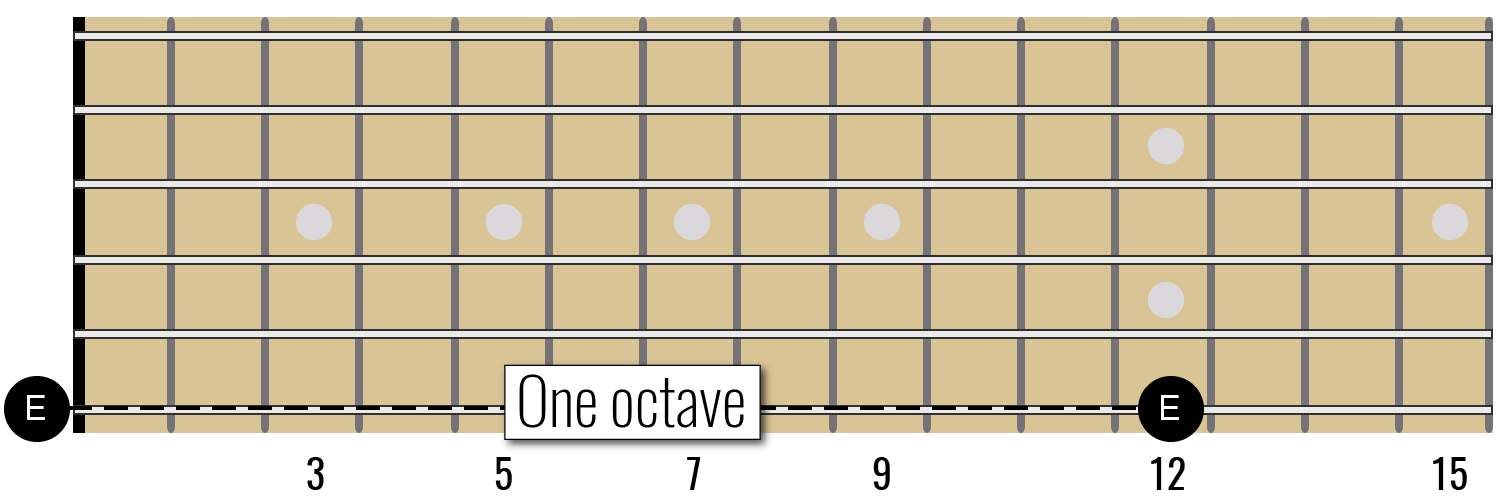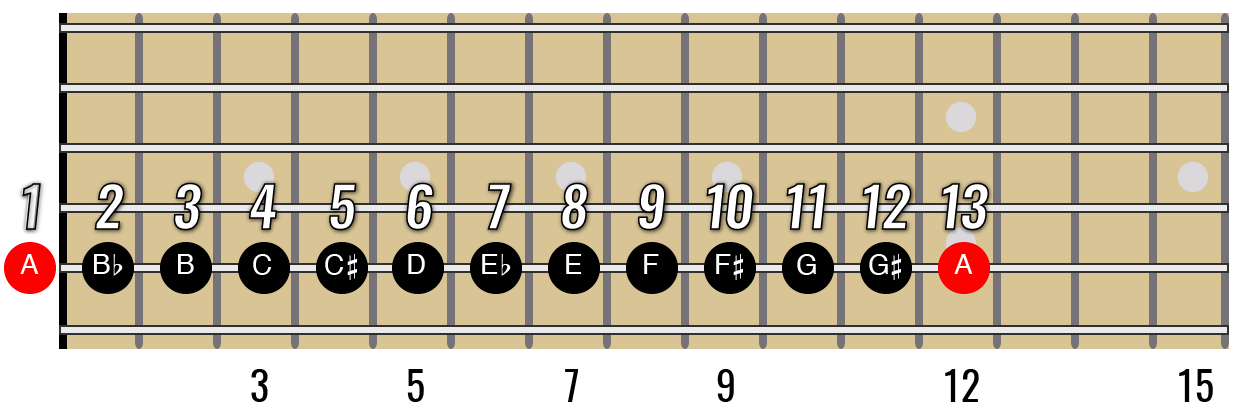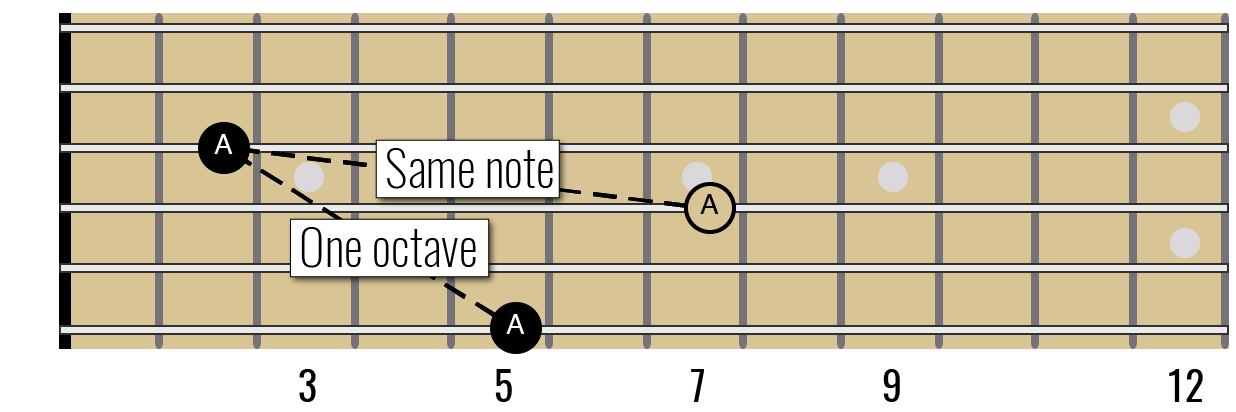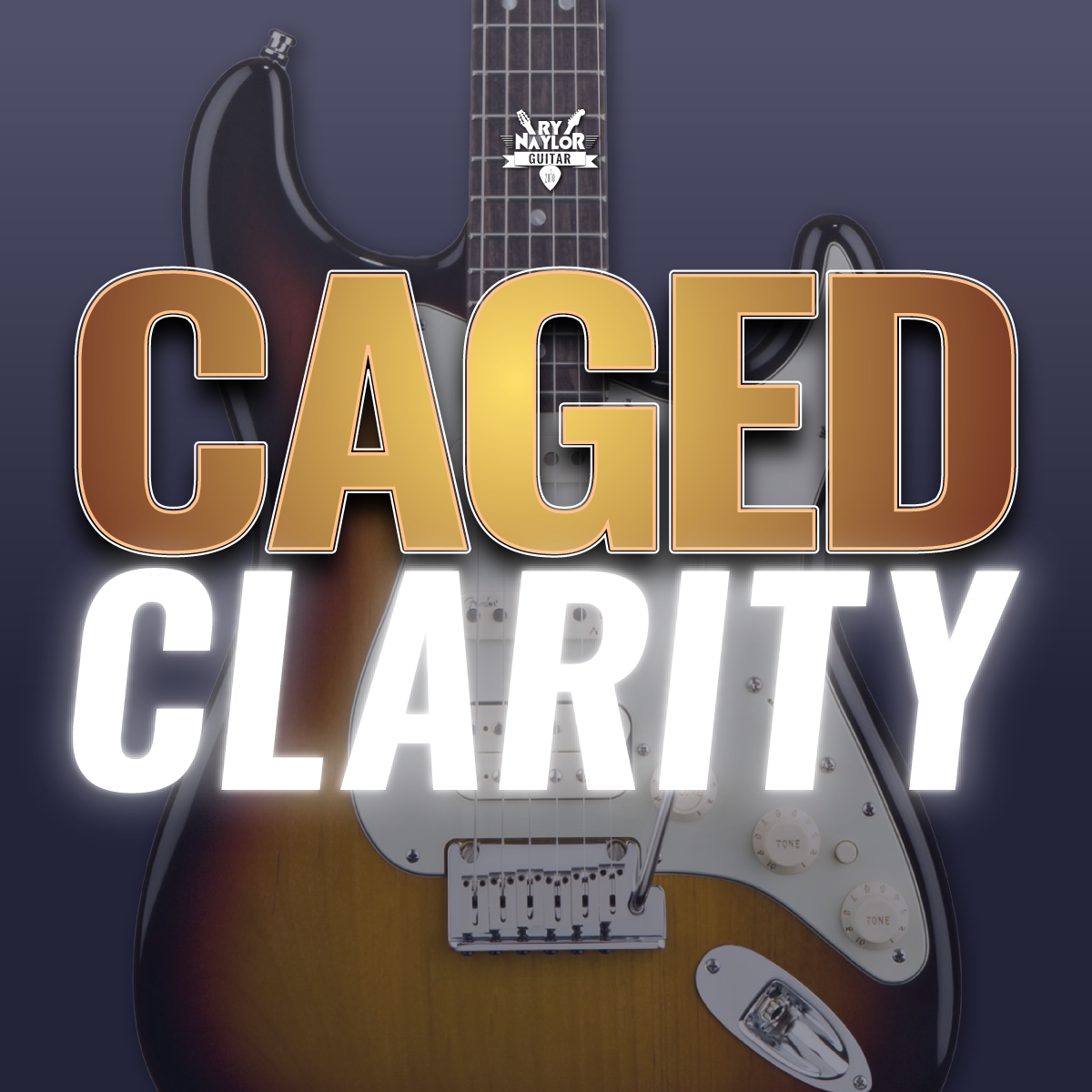Guitar Octave Shapes (Part 1)
/Guitar octave shapes are essential learning to give you more confidence when navigating the guitar.
For memorizing the guitar fretboard they will help you to locate notes effortlessly from frets where you can already name the notes (normally string 6(E) and 5(A) which you learn first to correctly place all those barre chords and power chords).
Octave shapes give you a framework when learning scale patterns. You’ll see the start and endpoint of a scale shape, and easily source any interval in the scale in a higher (or lower) octave.
Knowing octave shapes on guitar will also allow a better understanding of chord shapes, identifying the different intervals and even tweaking them when required to give you different types of chords.
So let’s get stuck in and learn some guitar octaves!
What is an octave?
Simply put, an octave is going up (or down) the musical alphabet and stopping at the starting note.
So, if you start from an A and move higher in pitch around the musical alphabet:
A...B...C...D...E...F...G...A
When you are back at the A, you're playing an octave above the starting A note. Think
Octopus...8 limbs.
Octave...8 notes!
What are guitar octaves?
Guitar octaves are simply the various linking patterns that are formed when we join notes that are an octave apart on the guitar fretboard.
How many octaves are there on a guitar?
In standard tuning, there are three octaves between the open string 6 (E) and the 12th fret of string 1(E). So all guitars have at least three octaves that are comfortable to play.
There are though more frets beyond the 12th which are playable, especially on electric guitars.
On a 24-fret guitar in standard tuning, there are four octaves. A 22-fret guitar has just one whole step less.
FOUR OCTAVES (THE 8va SYMBOL IN THE MUSIC MEANS ‘OCTAVE ABOVE’)
How to learn guitar octaves
Let’s take it from the top.
Have you ever wondered why there are two dots at the 12th fret on the guitar fretboard?
It’s because the 12th fret is the octave of the open string. When you play the 12th fret, you are hearing a note an octave above the open string.
Play the open string 6(E) then play the 12th fret. Hear how they're the same...but different. The 12th fret is an E note one octave higher.
12TH FRET OCTAVE OF THE OPEN STRING
GUITAR OCTAVE ON ONE STRING
Knowing that gives you a helpful guitar fretboard reference point where you can be confident of the note names. The 12th fret notes (from low to high) are E A D G B E.
12th FRET fretboard reference point
But hang on...you said an octave was 8 notes. Why is the octave at the 12th fret?!
It's because there are actually more than 8 notes in an octave.
THE NOTE CLOCK
Contained within an octave are thirteen notes separated by twelve half steps.
Let's have a look at my note clock to confirm that.
If you start at A and count every single note, including the A at the beginning and the end, that's thirteen notes.
13 notes? Don't forget that in counting the notes up to the 12th fret you'd also include the open string, a total of thirteen notes, each separated by one fret (a half step).
AN OCTAVE CONTAINS 13 NOTES
Guitar octave shape on one string
Taking the 12th fret concept a little further, it means that the octave of any note on any string can be found by adding 12 frets.
The octave of the A note at the 5th fret of string 6(E) will be….5 plus 12…the 17th fret.
ADd 12 frets for the octave of any note
Explore that a little bit. Play any note, then find its octave 12 frets higher on the same string.
Guitar octaves on adjacent strings
By adjacent strings, I mean strings that sit next to one another, like string 6(E) and 5(A).
If we apply the concept of moving a note to the string below (hint: lower five frets), the octave at the 12th fret on string 6(E) can be found at the 7th fret on string 5(A).
THE Octave of an open string is at the 7th fret of the string below (towards the floor)
The 7th fret is where you’ll find the octave of the string above, making it another essential fretboard reference point. As is always the case, the octave shape is slightly different between strings 3(G) and 2(B) because of the difference in standard tuning.
The octave above the open string 3(G) is the 8th fret of string 2(B).
Again, this octave shape could be moved away from the open strings. You simply add 7 frets (or 8 for string 2(B)) to find the octave of your starting note.
Guitar octave shapes skipping over strings
The remaining octave shapes are formed when you skip or jump over one or more strings.
6-4 Octave Shape
The first of which is the 6-4 octave shape. The octave above any note on string 6(E) can be found two frets higher on string 4(D).
For example, the octave above the A note at the 5th fret of string 6(E) will be…5 plus 2…the 7th fret of string 4(D).
6-4 octave shape
This is a shape you may be familiar with if you have learned power chords. The basic Root-5th shape can be extended to add an octave root note on string 4(D) in the same fret as the 5th.
A5 power chord (extended shape)
That octave shape will work from any fret on string 6(E), so if you’ve been learning string 6(E) for your moveable chord shapes, you’ll be able to effortlessly name notes on string 4(D).
5-3 Octave Shape
As with any pattern on the guitar fretboard, the 6-4 octave can be moved vertically across the string sets (moving downwards towards the floor).
The 5-3 octave shape is identical in appearance. The octave above any note on string 5(A) can be found two frets higher on string 3(G).
For example, the octave above the D note at the 5th fret of string 5(A) will be…5 plus 2…the 7th fret of string 3(G).
5-3 octave shape
4-2 Octave Shape
Remember that when moving any shapes across the string sets any note that is moved from string 3(G) to string 2(B) must be raised up one fret towards the guitar body to maintain the same distance.
Therefore, for the 4-2 octave shape, the note moving from string 3(G) to 2(B) must be raised one fret (towards the guitar body) for the octave to be intact.
The octave of any note played on string 4(D) can be found three frets higher on string 2(B).
4-2 octave shape
3-1 Octave Shape
Moving the octave down for a 3-1 octave shape, the pattern remains the same as no note has crossed from strings 3(G) to 2(B).
The octave of any note played on string 3(G) can be found three frets higher on string 1(E).
3-1 octave shape
That concludes what I like to call the ‘forward-facing’ octave shapes, with the octave being found in a higher fret.
It is possible to form another octave shape when skipping over two strings. Doing so finds the octave note in a lower fret. Let’s reset back to string 6(E).
6-3 Octave Shape
Starting with the 6-4 octave shape, the note on string 4(D) can be found 5 frets lower on string 3(G), creating the first ‘backward-facing’ octave shape.
creating the 6-3 octave shape
The octave above any note on string 6(E) can be found three frets lower on string 3(G).
For example, the octave above the B note at the 7th fret of string 6(E) will be…7 minus 3…the 4th fret of string 3(G).
6-3 octave shape
5-2 Octave Shape
You can lower the 6-3 octave shape onto strings 5(A) and 2(B).
Remember that the note moving from string 3(G) to 2(B) must be raised one fret (towards the guitar body) for the octave to remain.
Therefore, the octave of any note played on string 5(A) can be found two frets lower on string 2(B).
The octave above the E note at the 7th fret of string 5(A) will be…7 minus 2…the 5th fret of string 2(B).
5-2 octave shape
4-1 Octave Shape
The third and final backward-facing octave is between strings 4(D) and 1(G). The shape remains the same as the 5-2 octave.
The octave of any note played on string 4(D) can be found two frets lower on string 1(E).
4-1 octave shape
There is no backward-facing octave shape from string 3(G). You’ve ran out of strings!
Two-Octave Shape
Nearly there! There is just one more shape that you should know. This is the 2-octave shape i.e. twice around the musical alphabet.
There is a two-octave distance between the open string 6(E) and 1(E).
Any note on string 6(E) will be in the same fret on string 1(E).
two-octave shape
Therefore, if you know the notes on string 6(E) you also know everything on string 1(E).
In the next installment of Guitar Octave Shapes, we’ll be considering how the octave shapes link up across the entire fretboard, and how that can form the foundation of the CAGED system.
Your to-do List
Play through each of the forward-facing octave shapes, remembering where you need to raise (or lower) the octave note. Staying in the same fret, play 6-4, 5-3, 4-2, 3-1, and then return back to the start - 3-1, 4-2, 5-3, 6-4.
Repeat that with the backward-facing octave shapes. Staying in the same fret play 6-3, 5-2, 4-1, and then return back to the start - 4-1, 5-2, 6-3.
Don’t worry if you don’t have the fretting hand dexterity to play both notes at the same time. The key thing is to memorize the location of the octave note.
Choose any note at random and see how many octaves of that note you can find (higher and lower).
Same string
Adjacent string
String skip
For More
Here’s a lesson from 2016(!) in which I break down all the octave shapes
